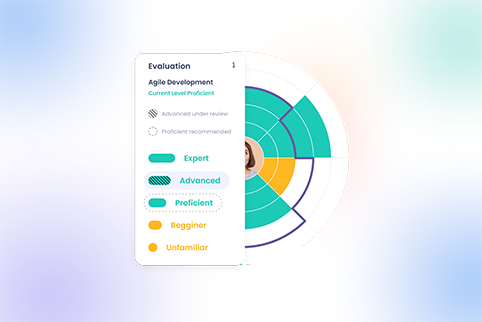Upskilling: Effective Methods and Success Stories
11 min read

In a fast-paced world with an uncertain economy, upskilling, reskilling, and skills-based internal mobility have become critical initiatives that HR departments and business leaders are looking at as possible solutions to their current and future challenges.
And these initiatives could have a huge impact. For example, “wide-scale investment in upskilling has the potential to boost global GDP by 5-6.5 trillion USD by 2030”, according to a World Economic Forum report.
With the significance of upskilling in mind, we’ll explore the main skills gaps in work environments, some of the key upskilling initiatives you can implement, and a few successful examples of upskilling programs.
Major skills gaps faced by organizations
The type and level of skills gaps will vary from one company to another. But they definitely exist and the impact is real. A McKinsey survey reveals that 87% of organizations are either already facing this issue or expect to in the next few years.
It’s important to point out that skills gaps and upskilling — the solution — can encompass both soft and hard skills. And the best way to find out how your workforce stacks up is with an in-depth skills gaps analysis. This analysis, together with a mapping of critical roles and current (and future) abilities should be part of any healthy upskilling strategy.
Still, there are certain areas where gaps are more likely to be present, including:
Digital skills gaps
In today’s fast-paced, technology-driven work environment, possessing transferable digital skills is becoming increasingly important for almost all job roles and industries.
But the rapid pace of technological change means that many workers are struggling to keep up with the latest digital tools and platforms, as well as privacy and security measures.
The direct result is a decrease in productivity and competitiveness for businesses, especially in industries where employees need specialized digital skills. Another consequence is the increased competition for qualified workers and longer periods of vacancy since the hiring process is hindered by the talent shortage.
Some of the most important digital skills that organizations need to address include but aren’t limited to:
- Artificial Intelligence (AI): While there’s a lot of buzz around AI (generative) tools, there’s no denying that they are becoming increasingly important for automating processes, making data-driven decisions, and improving customer experiences. Still, these tools require human input and thus training to make the most out of them.
- Cloud Computing: While it is an essential aspect of remote work, using the cloud to store data and run applications is now common practice for most organizations. And as such, employees need to learn how to use and collaborate across these platforms.
- Cyber Security: While not as attractive as AI or as fun as Social Media Marketing, there is a growing need for workers to step up their game when it comes to cybersecurity. In a world where fake web pages, emails, and now voices, are becoming more convincing than ever, knowing how to prevent and respond to a scam or a cyberattack is crucial.
- Data Analysis: While initially, you might think this skill is more relevant to people in specialized industries, don’t make a mistake. Data-driven decision-making applies to any team and department, and learning how to gather, sort, and extract insight from data is more important than ever.
- Social Media Marketing: While (almost) everybody has social media accounts, not everybody knows how to make the most out of these platforms to promote their brand, engage customers, or drive growth in sales.
Embracing upskilling and addressing digital skills gaps has become a must for businesses that want to remain competitive in the digital age and ensure their workforce functions at its full potential.
Soft skills gaps
Another area where organizations are witnessing significant gaps is soft, or as Simon Sinek likes to call them, human skills:
For somebody to truly perform, I’m going to teach you hard skills, which are the skills you need to do your job. And I’m going to teach you human skills, which are the skills you need to be a better human. And if you can master both of those, you will thrive at this organization.
— Simon Sinek
Like digital skills, these are also transferable abilities, which allow people to communicate, collaborate, and develop healthy relationships at work. Soft skills are also one of the necessary ingredients to create a nurturing company culture.
Here are some of the human skills we recommend including in your upskilling initiatives:
- Empathy: Perhaps the most important human skill at work, empathy is our superpower. It’s what allows us to understand colleagues, and their intentions, and to create true and meaningful connections.
- Communication: There’s a reason communication skills show up every time there’s a discussion about soft or work skills in general. They impact almost every interaction, be it with colleagues or clients, and can often make or break career aspirations, especially for those interested in managerial roles.
- Teamwork: In many jobs, the ability to work with others seamlessly is essential. And it’s a skill that can be mastered in time, even by employees who are more introverted or who are used to working on their own.
- Conflict resolution: When not addressed, conflicts can decrease productivity and even create a toxic work culture in the long run. That’s why it’s important to know how to identify the root cause of conflicts, listen to different perspectives, and find mutually acceptable solutions.
- Problem-solving: Challenges are a part of work (and life) and knowing how to analyze problems and come up with possible solutions will prove to be valuable in many job roles. Problem-solvers rely on critical thinking and collaboration to find the best solutions to problems at work.
The importance of bridging the soft skills gap is further emphasized by LinkedIn data, which reveals:
91% of talent professionals say soft skills are very important to the future of recruiting and HR. The same report concluded that 89% say bad hires typically lack soft skills and 57% of companies struggle to assess soft skills accurately.
— LinkedIn
How to upskill employees: methods and tools
Now that we’ve gone over some of the major areas where upskilling is imperative, it’s time to look at actual upskilling initiatives and methods. Keep in mind that a successful upskilling strategy is usually flexible and combines multiple approaches and resources to achieve the desired outcome.
New learning ecosystems
Perhaps one of the most interesting approaches to upskilling is the one we’re seeing implemented in Singapore, where institutions of higher learning have started turning into institutions of continual learning.
This is an effort that involves the collaboration of the government, education institutions, and enterprises — all to help people become and remain ready for the job market, both now and in the future.
Through this collaboration, curricula will stay up-to-date and will constantly evolve based on changing business needs and the necessary skills of future employees. Programs and courses will also become flexible, enabling everybody to keep learning, even those who have already entered the job market.
Due to the fast-evolving business landscape, formal education will not be sufficient to prepare individuals for their entire career. Bite-size, personalized and flexible learning programs can better help working individuals learn new skills that align with their career aspirations.
— EY
Coaching
Coaching is an upskilling method that is increasingly being used in the corporate environment. It typically involves regular one-on-one sessions, during which the coach:
- provides guidance and support
- asks questions to help the employee identify improvement opportunities
- offers feedback on progress
One of the stand-out benefits of coaching is that it is tailored to the individual needs of the employee, which allows them to focus on the areas where they need most help. It is also a more personalized and flexible approach when compared to traditional training or learning methods, such as online courses or group workshops.
To be successful, coaches need to help people identify their strengths and weaknesses, set goals, and develop a mutually agreed plan of action to achieve them.
Mentoring
Unlike coaching, mentoring is often a longer-term relationship between a more experienced and knowledgeable person (mentor) and a less experienced employee (mentee).
The reason why mentoring can be a hugely successful upskilling method is the fact that it helps workers develop skills that aren’t always easily taught through formal training or learning programs. Or, in other words, employees develop knowledge that wouldn’t otherwise be (easily) available.
The relationship between the mentor and the mentee can focus on specific skills or interests, like project management, or on general guidance, perhaps related to career development or making the right lateral move within the company.
Mentoring also has a positive impact on the company culture, since it creates a stronger sense of community and deep connections built on trust and mutual respect.
Peer-to-peer learning
Peer-to-peer learning or learning through collaboration may be one of the simplest and yet most impactful upskilling efforts. It involves employees learning from each other, usually (but not always) within the same team or department.
The beauty of peer-to-peer learning is that while it can be initiated — and thrives with support from — the organization, it works just as well when workers start it out of their own initiative.
It is one of the most cost-effective upskilling methods while still providing a great development experience. That’s because learning from and with peers provides real-world examples and insights from hands-on experiences, which are often more valuable than theoretical (online) courses.
Leadership development programs
Unlike the other upskilling methods we’ve explored so far, leadership development programs don’t target all employees, focusing instead on the high-performers with the potential and desire to make vertical moves in their careers. The aim is to help them:
- become more effective leaders
- manage teams more efficiently
- drive business results
During leadership development programs, employees can focus on improving in a variety of areas, including public speaking, strategic thinking, project management, decision-making, etc.
It’s not uncommon for companies to collaborate with third-party providers when offering this type of upskilling. But the advantage of offering them using internal resources is being able to address specific skills (gaps) related to the organization’s goals.
The obvious and most important benefit of leadership development programs is that companies can build a strong pipeline of future leaders. It’s a very effective way of developing a talent pool of high-performing individuals who will be ready to take on leadership roles in the future.
Companies with successful upskilling initiatives
To prove that upskilling isn’t just the passing fad in the endless sea of business trends, here are a few attention-worthy examples from companies that have successfully implemented upskilling initiatives:
Capital One
Capital One has adopted a strategy of upskilling and cross-training its employees to tackle a talent shortage in tight labor markets. The company’s approach is focused on “developing the whole person” via a range of programs, including:
- a full-stack development academy
- an internal “tech college”
- leadership development
- other soft-skills training
The Capital One Developer Academy (CODA) is perhaps the most successful program, with over 200 people being hired annually after graduating.
And this approach is paying dividends in more ways than one. For instance, their culture of learning and the “entrepreneurial spirit” has also helped to attract new engineering talent to the firm.
Verizon
One of the largest global mobile network operators, Verizon, provides free online technical and soft skills training (in partnership with Generation USA) to prepare American workers for future tech careers.
Participants have the freedom to choose from various 10- to 15-week programs in fields like cybersecurity, IT support, or web development among others. And the company doubles down on its efforts by supporting participants to continue their education or find employment afterward.
According to Verizon, 70% of program graduates find jobs within 3 months of graduation and they are committed to training 500,000 workers for in-demand tech jobs by 2030.
Walmart
In 2021, Walmart announced that it would pay 100% of college tuition and books for associates through its Live Better U (LBU) education program, removing the previous 1 USD per day fee.
At the time, this meant 1.5 million Walmart and Sam’s Club associates in the US could finally earn college degrees or learn trade skills without the burden of education debt. And so far, the results speak for themselves:
- over 330 million USD in tuition savings since LBU launched
- 66% increase in enrolment since the 1 USD/day fee was removed
- LBU participants are 2 times more likely to be promoted
- LBU participants are 4 times more likely to stay at Walmart
By the end of 2022 alone, over 89,000 associates had already participated in LBU, and more than 15,000 had completed a degree or program. And Walmart continues to honor its initial commitment to invest nearly 1 billion USD in career-driven training and development until 2026.







